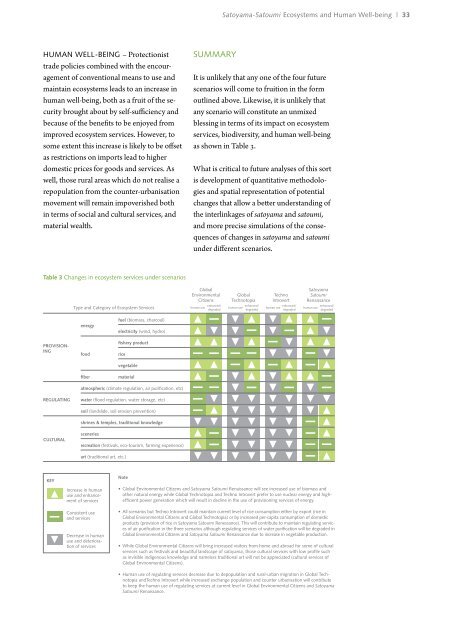Satoyama-Satoumi Ecosystems and Human Well-Being - UNU-IAS ...
Satoyama-Satoumi Ecosystems and Human Well-Being - UNU-IAS ...
Satoyama-Satoumi Ecosystems and Human Well-Being - UNU-IAS ...
Create successful ePaper yourself
Turn your PDF publications into a flip-book with our unique Google optimized e-Paper software.
<strong>Satoyama</strong>-<strong>Satoumi</strong> <strong>Ecosystems</strong> <strong>and</strong> <strong>Human</strong> <strong>Well</strong>-being | 33<br />
<strong>Human</strong> well-being – Protectionist<br />
trade policies combined with the encouragement<br />
of conventional means to use <strong>and</strong><br />
maintain ecosystems leads to an increase in<br />
human well-being, both as a fruit of the security<br />
brought about by self-sufficiency <strong>and</strong><br />
because of the benefits to be enjoyed from<br />
improved ecosystem services. However, to<br />
some extent this increase is likely to be offset<br />
as restrictions on imports lead to higher<br />
domestic prices for goods <strong>and</strong> services. As<br />
well, those rural areas which do not realise a<br />
repopulation from the counter-urbanisation<br />
movement will remain impoverished both<br />
in terms of social <strong>and</strong> cultural services, <strong>and</strong><br />
material wealth.<br />
Summary<br />
It is unlikely that any one of the four future<br />
scenarios will come to fruition in the form<br />
outlined above. Likewise, it is unlikely that<br />
any scenario will constitute an unmixed<br />
blessing in terms of its impact on ecosystem<br />
services, biodiversity, <strong>and</strong> human well-being<br />
as shown in Table 3.<br />
What is critical to future analyses of this sort<br />
is development of quantitative methodologies<br />
<strong>and</strong> spatial representation of potential<br />
changes that allow a better underst<strong>and</strong>ing of<br />
the interlinkages of satoyama <strong>and</strong> satoumi,<br />
<strong>and</strong> more precise simulations of the consequences<br />
of changes in satoyama <strong>and</strong> satoumi<br />
under different scenarios.<br />
Table 3 Changes in ecosystem services under scenarios<br />
Type <strong>and</strong> Category of Ecosystem Services<br />
Global<br />
Environmental<br />
Citizens<br />
human use<br />
enhanced/<br />
degraded<br />
Global<br />
Technotopia<br />
Techno<br />
Introvert<br />
enhanced/<br />
enhanced/<br />
human use human use human use<br />
degraded<br />
degraded<br />
<strong>Satoyama</strong><br />
<strong>Satoumi</strong><br />
Renaissance<br />
enhanced/<br />
degraded<br />
PROVISION-<br />
ING<br />
energy<br />
food<br />
fiber<br />
fuel (biomass, charcoal)<br />
electricity (wind, hydro)<br />
fishery product<br />
rice<br />
vegetable<br />
material<br />
atmospheric (climate regulation, air purification, etc)<br />
REGULATING<br />
water (flood regulation, water storage, etc)<br />
soil (l<strong>and</strong>slide, soil erosion prevention)<br />
shrines & temples, traditional knowledge<br />
CULTURAL<br />
sceneries<br />
recreation (festivals, eco-tourism, farming experience)<br />
art (traditional art, etc.)<br />
KEY<br />
Increase in human<br />
use <strong>and</strong> enhancement<br />
of services<br />
Consistent use<br />
<strong>and</strong> services<br />
Decrease in human<br />
use <strong>and</strong> deterioration<br />
of services<br />
Note<br />
• Global Environmental Citizens <strong>and</strong> <strong>Satoyama</strong> <strong>Satoumi</strong> Renaissance will see increased use of biomass <strong>and</strong><br />
other natural energy while Global Technotopia <strong>and</strong> Techno Introvert prefer to use nuclear energy <strong>and</strong> highefficient<br />
power generation which will result in decline in the use of provisioning services of energy.<br />
• All scenarios but Techno Introvert could maintain current level of rice consumption either by export (rice in<br />
Global Environmental Citizens <strong>and</strong> Global Technotopia) or by increased per-capita consumption of domestic<br />
products (provision of rice in <strong>Satoyama</strong> <strong>Satoumi</strong> Renessance). This will contribute to maintain regulating services<br />
of air purification in the three scenarios although regulating services of water purification will be degraded in<br />
Global Environmental Citizens <strong>and</strong> <strong>Satoyama</strong> <strong>Satoumi</strong> Renaissance due to increase in vegetable production.<br />
• While Global Environmental Citizens will bring increased visitors from home <strong>and</strong> abroad for some of cultural<br />
services such as festivals <strong>and</strong> beautiful l<strong>and</strong>scape of satoyama, those cultural services with low profile such<br />
as invisible indigenous knowledge <strong>and</strong> nameless traditional art will not be appreciated (cultural services of<br />
Global Environmental Citizens).<br />
• <strong>Human</strong> use of regulating services decrease due to depopulation <strong>and</strong> rural-urban migration in Global Technotopia<br />
<strong>and</strong>Techno Introvert while increased exchange population <strong>and</strong> counter urbanisation will contribute<br />
to keep the human use of regulating services at current level in Global Environmental Citizens <strong>and</strong> <strong>Satoyama</strong><br />
<strong>Satoumi</strong> Renaissance.
















